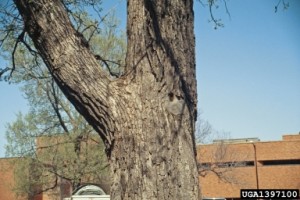Worried About The Safety Of Your Tree? Book A Consultation With One Of Our Certified Arborists To Inquire About Our Storm Proof Package.
Hazardous trees pose a danger to people and property. When storms or high winds hit, limbs – and often whole trees – fall to the ground.
“Many fatal accidents and millions of dollars in property damage can be averted if homeowners heed the warning signs of a hazardous tree,” explains Tchukki Andersen, BCMA, CTSP* and staff arborist for the Tree Care Industry Association (TCIA). “By not paying attention to your trees, you are potentially placing your property, even your life, in jeopardy.”
Tree defect clues
Branches: Fortunately, one can often read the clues that indicate a tree is prone to failure. For instance, if a tree has large branches attached with tight, V-shaped forks, you should consider having those branches removed or lightened.
Cracks: Other warning signs of structural instability include cracks in the trunk or major limbs, hollow and decayed areas, or the presence of extensive dead wood.
Fungi: Mushrooms growing from the base of the tree or under its canopy may be a sign of root decay. Remember to be thorough in your evaluation; the absence of fungus growth does not necessarily mean the tree is healthy.
 Construction: “It also pays to be highly suspicious of any tree that has had construction activities – such as trenching, addition or removal of soil, digging or heavy equipment movement – anywhere under the spread of its branches,” says Andersen. These activities can cause root death, which in turn could lead to the structural instability of the tree.
Construction: “It also pays to be highly suspicious of any tree that has had construction activities – such as trenching, addition or removal of soil, digging or heavy equipment movement – anywhere under the spread of its branches,” says Andersen. These activities can cause root death, which in turn could lead to the structural instability of the tree.
Hollow Tree: The sign most people recognize is a hollow in a tree. But even a large hollow does not necessarily signify a tree has become hazardous. Nor does it mean the hollow should be filled. Filling of hollow trees, a process called “cavity filling,” was practiced by Arborists for many years. However, thanks to recent research, it has been discovered that cavity filling is not needed to support or improve the health of hollow trees. Tree experts found that cavity filling with cement can actually damage a tree. According to Andersen, “the column of cement created in the tree by a cavity fill doesn’t move, just like a column on a building, but the tree is always moving. It sways with the wind constantly. The rubbing created by the swaying tree and the solid column of cement can further damage the tree.”
Solutions
If your tree is not structurally sound there are a number of solutions such as bracing, cabling, crown reduction, or removing of the tree. A Certified Arborist will be able to recommend the best course of action for your tree.
Worried your tree will fall during upcoming winter storms? Book a consultation with an Arborist to discuss our Storm Proof package which includes crown reduction, cables, and a tree growth regulator treatment.
Article Provided By The Tree Care Industry Association (TCIA)


